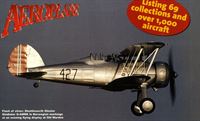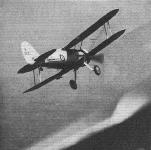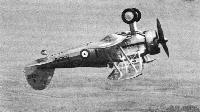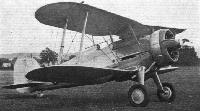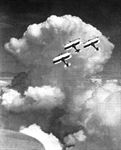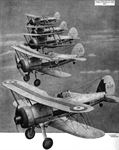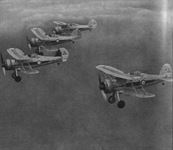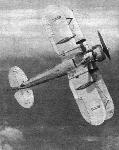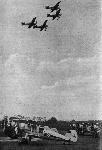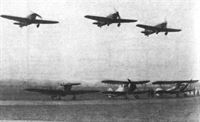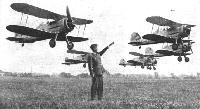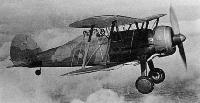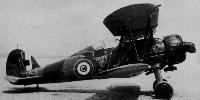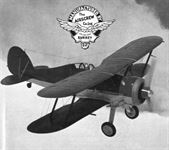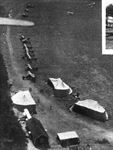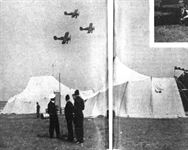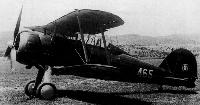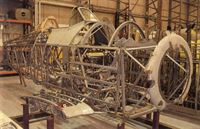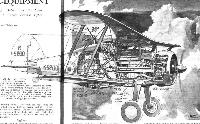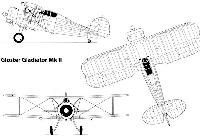
Варианты
- Gloster - Gladiator - 1934 - Великобритания
- Gloster - Sea Gladiator - 1938 - Великобритания
Gladiator
Одноместный истребитель, цельнометаллический биплан с закрытой кабиной и неубирающимся шасси. Спроектирован в КБ фирмы "Глостер эйркрафт компани" под руководством Г. Фолланда. Опытный образец SS.37 впервые поднялся в воздух 12 сентября 1934 г. Строился с января 1937 г. на заводе "Глостер" в Хакклкоте. Всего выпущено 587 экз. Вооружение 4x7,69. Состоял на вооружении в Великобритании с февраля 1937 г., в Норвегии - с июля 1937 г., в Литве - с октября 1937 г., в Бельгии - с сентября 1937 г.; в Греции - с января 1938 г., в Китае - с ноября 1938 г., в Финляндии - с декабря 1939 г., в Ираке и ЮАС - с 1941 г.
Основные серийные модификации:
- "Гладиатор" I с мотором "Меркьюри" IX, двухлопастным винтом;
- "Гладиатор" II с мотором "Меркьюри" VIII или VIIIAS, трехлопастным винтом.
Существовал также палубный вариант, именовавшийся "Си Гладиатор". Первое боевое использование - в Китае под Кантоном в декабре 1938 г. В Финляндии применялся в "зимней" войне и позднее в 1941 - 1942 гг. Норвежские истребители участвовали в оборонительных боях в апреле - июне 1940 г. "Гладиаторами" были вооружены части британского экспедиционного корпуса во Франции (декабрь 1939г. - май 1940 г.). С июня 1940 г. английские истребители сражались в Северной Африке, на Мальте и в Греции. Бельгийские "гладиаторы" обороняли свою страну от немцев в мае 1940г. Южноафриканские самолеты воевали в 1941 г. в Сомали и Эфиопии против итальянцев. Иракские машины в том же году участвовали в пронемецком мятеже Рашида Али и были почти полностью уничтожены английской авиацией. Несколько литовских истребителей вошли в состав ВВС РККА и применялись в июне 1941 г. "Гладиатор" снят с производства в апреле 1940 г. В Великобритании использовался как истребитель до 1942 г., снят с вооружения в 1945 г. В Финляндии снят с вооружения в 1942 г.
"Гладиатор" I||
Размах:||9,83 м
Длина:||8,36 м
Моторы, количество х мощность:||1x830 л.с.
Взлетная масса, максимальная:||2083 кг
Максимальная скорость:||407 км/ч
Практический потолок:||10000 м
Дальность:||690 км
Описание:
- Gladiator
- Gloster Gladiator
- Flight, June 1935
NEW and EXPERIMENTAL TYPES at HENDON - Flight, November 1935
FOR THE SERVICE ARENA - Flight, March 1937
ENTRY of the GLADIATOR - Flight, November 1939
Britain's Military Aircraft
Фотографии
-
Air Enthusiast 2007-07 / The Roundels File
Регистрационный номер: K6130 [5] Gloster Gladiator I K6130 of 72 Squadron, Church Fenton, June 1937/ October 1939. Flight leader's aircraft, either 'A' (red) or 'C' (blue) Flight; colours chosen opting for 'A'. below: Markings on top wing.
-
Air Enthusiast 2007-07 / The Roundels File
Регистрационный номер: K6136 [3] Gloster Gladiator I K6136 of 72 Squadron, Church Fenton, June 1937/October 1939. 'C' Flight, Squadron emblem in arrowhead.
-
Мировая Авиация 140
Регистрационный номер: K7918 Базировавшаяся в Хорнчерче 54-я эскадрилья ВВС сменила свои Gauntlet Mk II на Gladiator Mk I весной 1937 года. После боевой службы самолет K7918 был передан 8-й группе технического обслуживания, где он продолжал летать до июня 1944 года.
-
Air Enthusiast 2007-07 / The Roundels File
Регистрационный номер: K7920 Gloster Gladiator I K7920 of 54 Squadron, Hornchurch. Unusual fin marking of (possibly) a blue bar on red fin, possibly associated with the 1938 Air Exercises. Squadron emblem in spearhead on fin. The markings on K7920 were photographed during the 1938 Air Exercises and were different on each aircraft. They may have been a form of identification based on flight colours. If any reader can explain them it would be appreciated.
-
Air Enthusiast 2007-07 / The Roundels File
Регистрационный номер: K7960 [3] Gloster Gladiator I K7960 'P' of 3 Squadron, Biggin Hill, in May 1939. Aircraft of OC 3 Squadron and also CO RAF Biggin Hill, Sqn Ldr H H Chapman.
-
Air Enthusiast 2007-07 / The Roundels File
Регистрационный номер: K7985 [28] Gloster Gladiator I K7985 of 73 Squadron, Debden, June/November 1937. note: Gladiators were painted Aluminium overall, with black 8in fuselage and 20in underwing serials. Fuselage roundels were 25in, upperwing 40in and underwing 30in. below: Markings on top wing.
-
Air Enthusiast 2007-07 / The Roundels File
Регистрационный номер: K8027 Gloster Gladiator I K8027 of 87 Squadron, Debden, in 1938. 'C' (blue) Flight leader's aircraft. Was lead in a 'tied-together' aerobatic routine.
-
Мировая Авиация 67
Регистрационный номер: K8042 [2] Gloster Gladiator входит в число самых совершенных истребителей-бипланов мира. Его отличает закрытая кабина летчика с радиостанцией и кислородным оборудованием. В дополнение к фюзеляжным пулеметам истребитель вооружен крыльевыми пулеметами. К началу Второй мировой войны Gladiator устарел, но эти бипланы сражались в Норвегии, Африке и Греции, принимали участие в битвах за Францию и Британию, а также в обороне Мальты.
-
Мировая Авиация 80
Регистрационный номер: K8011 [2] На изображенном Gladiator I из 80-й эскадрильи Пэттл летал весной 1940 года, позже истребитель передали греческим ВВС. Пэттл одержал на биплане 15,5 побед, став лучшим асом, из летавших на истребителях-бипланах. Последнюю победу на Gladiator он одержал 9 февраля 1941 года над Тепеленой - сбил CR.42.
-
Авиация и Время 2005-01 / В.Мараев - Средиземноморский ас империи /Портреты/
Регистрационный номер: K8011 [2] Gladiator Mk.I флайт-л-та М.Т.Пэттла из 80-й АЭ британских ВВС. Египет, июль 1940г.
-
Aeroplane Monthly 1979-08 / Gloster Gladiator /Preservation Profile/ (76)
Регистрационный номер: K8032 [26], G-AMRK [26], K7985 [28], L8032 [26], N2038 [26] -
Авиация и Время 1999-03 / А.Котлобовский - За полвека до "Бури в пустыне" /Аэроархив/
Регистрационный номер: N2287 Gloster Gladiator Mk.II из 94-й АЭ ВВС Великобритании, а/б Шуэйба, май 1941г.
-
АвиаМастер 2000-02 / М.Никольский - Африканское эхо второй мировой /Неизвестная война/
Регистрационный номер: N5821 "Гладиатор" ВВС Южноафриканского союза, Кения, 1941г.
-
Авиация и Время 2005-01 / В.Мараев - Средиземноморский ас империи /Портреты/
Регистрационный номер: N5832 Gladiator Mk.II М.Т.Пэттла из 80-й АЭ британских ВВС. Греция, Янина, декабрь 1940г.
-
Air Enthusiast 1971-09 / R.Braybrook - Biplane Era: The Flight from Reality /Fighters in the RAF/ (1)
Регистрационный номер: N5902 [3] Gloster Gladiator II of No 25 Squadron (1939).
-
Air International 1986-08 / Model enthusiast
Регистрационный номер: N5902 [3] Gladiator II of No 521 Meteorological Calibration Sqn. This aircraft (N5902) was one of the final batch (of 50) built, and it should be noted that the code letters "ZK" were applicable to No 25 Sqn (which flew the Mk I between June 1938 and February 1939).
-
АвиаМастер 2000-02 / М.Никольский - Африканское эхо второй мировой /Неизвестная война/
Регистрационный номер: N5852 "Гладиатор" капитана Бойла из 1-й южноафриканской эскадрильи, ноябрь 1940г.
-
Air International 1986-08 / Model enthusiast
Gladiator I operated by the 1ere Escadrille (La Comete) of the 2eme Regiment d'Aeronautique of Belgium's Aeronautique Militaire at Diest-Schaffen on 10 May 1940. The Aeronautique Militaire acquired 22 Gladiator Is delivered between September 1937 and May 1938, but only 13 were on the strength of La Comete when the German assault commenced.
-
Мировая Авиация 20
Gloster Gladiator Mk I. 1-я эскадрилья 1-й группы 2-го авиаполка (1/1/2), действовавшая с базы Шаффен, имела на вооружении 15 истребителей Gladiator. Эта эскадрилья была известна как "Lа Comete" ("Комета"), и ее самолеты несли на бортах соответствующие эмблемы.
-
АвиаМастер 2003-04 / М.Жирохов - Они сражались за Фландрию. Бельгийские ВВС во второй мировой войне /Из истории воздушных войн/
"Гладиатор" капитана Макса Гусганда, командира эскадрильи "Ла Комет", аэродром Шаффен, апрель 1940г.
-
История Авиации 2002-02 / И.Сеидов - Оружие смелых /Маленькие эпизоды больших войн/ (2)
"Гладиатор" Mk.I командира 28-й эскадрильи Гоминдановских ВВС майора Арта Чина.
-
Авиация и Время 2010-06 / А.Демин - Воздушные драконы Поднебесной (11)
Gladiator Mk.l м-ра Арта Чина, командира 28-й АЭ ВВС Китая. Провинция Гуандун, весна 1938 г.
-
АС 1993-01 / М.Хайрулин - Крылья Литвы /Авиация стран мира/
Регистрационный номер: G-709 [3] Gloster Gladiator I (N G-709) на аэродроме в г.Шауляй, конец июня 1941г.
-
Мир Авиации 1992-01 / А.Котлобовский - ВВС Финляндии в Зимней войне /Война в воздухе/
Gladiator Mk.I шведской флотилии F-19. Размещение опознавательных знаков снизу нижнего крыла нетипично для финских "Гладиаторов".
-
АвиаМастер 2002-05 / М.Жирохов, М.Морозов - Волонтеры зимней войны /Малоизвестные страницы/
Два "Гладиатора" из состава шведской добровольческой "Авиафлотилии 19", январь-февраль 1940г.
-
История Авиации 35 / О.Киселев - Истребители И-16 в Зимней войне 1939-1940гг. /Страницы боевой карьеры/ (4)
Регистрационный номер: GL-253 5 марта 1940 г. "Гладиатор Mk.ll" (борт. GL-253) сержанта С.Витикайнена из состава LeLv 12 попал в серьёзный передряг, будучи перехвачен "ишачками" 44-го ИАП. Хотя его пилоту удалось довести машину до аэродрома, но полученные повреждения оказались настолько тяжёлыми, что самолет попал в аварию и был отправлен в ремонт.
-
История Авиации 2000-05 / А.Андреев - Ойва Туоминен /Асы мира/
Регистрационный номер: GL-255 [4] "Гладиатор"Mk.II сержанта Ойвы Туоминена из состава эскадрильи LeLv26. Карелия, февраль 1940г.
-
Авиация и Космонавтика 2017-04 / М.Тимин - Неизвестный подвиг летчика Михина
Регистрационный номер: GL-255 [4] Реконструкция внешнего вида «Гладиатора» GL-255 Ойвы Туоминена
-
Мировая Авиация 205
Регистрационный номер: GL-256 [2] На этом Gladiator Mk II GL-256 летал капрал Илмари Ёенсуу из подразделения 2/LLv 26, в феврале 1940 года базировавшегося в Руоколахти. Летчик одержал на этом самолете четыре победы, а статус аса получил в августе 1941 года, уже летая на Fiat G.50.
-
История Авиации 34 / О.Киселев - Истребители И-16 в Зимней войне 1939-1940гг. /Страницы боевой карьеры/ (3)
Регистрационный номер: GL-257 [3] "Гладиатор Mk.II" датского лётчика-добровольца Й.Ульриха, который 13 февраля 1940 г. был сбит в воздушном бою в районе Вяртсиля истребителями И-16 из состава группы Ткаченко ВВС 8-й армии. По результатам боя на счет пилотов группы Ткаченко было записано два "Гладиатора" и один D.XXI, которые поделили между собой лейтенант Я.Ф.Михин, пилотировавший И-16, и старший политрук М.А.Кочмала, летавший на И-15бис.
-
Авиация и Космонавтика 2017-04 / М.Тимин - Неизвестный подвиг летчика Михина
Регистрационный номер: GL-257 [3] Реконструкция внешнего вида «Гладиатора» Йорна Ульриха
-
История Авиации 36 / О.Киселев - Истребители И-16 в Зимней войне 1939-1940гг. /Страницы боевой карьеры/ (5)
Регистрационный номер: GL-258 [2] «Гладиатор Mk.II» GL-258 младшего сержанта Суканена из состава LLv 26. В ходе воздушного боя 25 февраля 1940 г., пилотировавший, посадил свой подбитый самолет на лес в районе Ристсеппяля, при этом истребитель был полностью разбит. Перед тем как разложить свой биплан финский летчик успел сбить один советский P-Z и повредить другой.
-
Air International 1986-08 / Model enthusiast
Регистрационный номер: GL-274 [3] Gladiator II (GL-274), one of 30 aircraft supplied to Ilmavoimat during December 1939 - February 1940, and flown by LeLv 26, 12 and 14 during the "Winter War" and LeLv 14 and 16 during the "Continuation War".
-
История Авиации 37 / О.Киселев - Истребители И-16 в Зимней войне 1939-1940гг. /Страницы боевой карьеры/ (6)
Регистрационный номер: GL-275 [2] "Гладиатор Mk.II" старшины Тиукайнена, сбитый в воздушном бою в районе деревни Пентиля 5 марта 1940 года. После окончания войны истребитель был отремонтирован. Самолёт несёт стандартный английский камуфляж конца 30-х годов с элементами быстрого опознавания принятыми в британском Истребительном Командовании - нижние поверхности левых консолей окрашены в чёрный цвет, а правых - в белый.
-
Aviation Historian 4 / R.Tisdale, A.Vercamer - Before & After
Gloster Gladiator I No 125 of the 1st Squadron, Latvian Air Force, was dispersed to Rumbull from Riga-Spilve on the morning of the Soviet invasion of Latvia on June 16, 1940
-
Aviation Historian 4 / R.Tisdale, A.Vercamer - Before & After
Latvia was under Soviet control by August 1940 and the surviving Gladiators were gathered at Krustpils, where some were crated for shipment to Germany. Others, including No 125, were marked for service in the Soviet Air Force
-
Aviation Historian 4 / R.Tisdale, A.Vercamer - Before & After
Records reveal that a number of Soviet Gladiators were captured by German forces, possibly including No 125, and used by the Luftwaffe to tow gliders for pilot training until all were withdrawn from use by March 1943
-
Мировая Авиация 15
Gloster Gladiator Mk II. ВВС Норвегии получили в общей сложности 12 истребителей Gloster Gladiator, первые шесть из них - в модификации Mk I. В боевых действиях приняло участие не менее 10 самолетов, все они были уничтожены на земле или в воздухе.
-
Air International 1986-08 / Model enthusiast
A Gladiator II of Portugal's Esquadrilha de Caca Expedicionaria Nr 2 at Achada (Terceira Isle) in the Azores in August 1941. Fifteen standard RAF Gladiators were switched to Portugal from a British Air Ministry contract in mid-1939 to supplement 15 aircraft that had been delivered to Alverca in the previous year, the aircraft illustrated (464) being the last (450-464) of the original batch.
-
Мировая Авиация 140
Gloster Gladiator Mk II из 2-й экспедиционной истребительной эскадрильи (Esquadrilha de Caqa Expedicionaria No.2) португальских ВВС, в августе 1941 года базировавшейся на Азорских островах.
-
Моделист-Конструктор Истребители Второй мировой войны
Регистрационный номер: K8032 [26], G-AMRK [26], K7985 [28], L8032 [26], N2038 [26] Истребитель Глостер "Гладиатор" I (Англия)
-
Jane's All the World Aircraft 1980 / Encyclopedia of Aviation - Aircraft A-Z - v3
Регистрационный номер: L8032 [26], G-AMRK [26], K8032 [26], N2038 [26] Gloster Gladiator.
-
Aeroplane Monthly 1976-05
Регистрационный номер: K8032 [26], G-AMRK [26], K7985 [28], L8032 [26], N2038 [26] The last airworthy Gloster Gladiator, K8032.
-
Aeroplane Monthly 1981-09
Регистрационный номер: L8032 [26], G-AMRK [26], K7985 [28], K8032 [26], N2038 [26] On April 20, 1981 the Shuttleworth Gladiator L8032 was taken for a high altitude airing for the benefit of AIR PORTRAITS’ camera. During the flight the aircraft reached 5,000ft, the highest it has flown for some time.
-
Aeroplane Monthly 1986-07
Регистрационный номер: L8032 [26], G-AMRK [26], K7985 [28], K8032 [26], N2038 [26] The Shuttleworth Collection's Spitfire VC, AR501, and Gladiator, L8032, photographed from its Hawker Hind over Old Warden in October 1985.
Другие самолёты на фотографии: Supermarine Spitfire Mk.V - Великобритания - 1941
-
Aeroplane Monthly 1986-09
Регистрационный номер: L8032 [26], G-AMRK [26], K7985 [28], K8032 [26], N2038 [26] The Shuttleworth Gloster Gladiator, L8032, photographed by AIR PORTRAITS en route from Mildenhall to Old Warden on Sunday, May 25, 1986.
-
Aeroplane Monthly 1986-09
Регистрационный номер: L8032 [26], G-AMRK [26], K7985 [28], K8032 [26], N2038 [26] The Shuttleworth Collection's Gloster Gladiator, the world's only airworthy example.
-
Мировая Авиация 84
Регистрационный номер: K7985 [28], G-AMRK [26], K8032 [26], L8032 [26], N2038 [26] Истребитель Gloster Gladiator (L8032) все еще может летать и демонстрируется с кодом K7985 73-й эскадрильи. Эдгар Джеймс Кейн совершил полет на реальном самолете с кодом K7985 в такой же окраске на воздушном параде в Хэндоне в 1937 году.
-
Air Enthusiast 2007-07 / The Roundels File
Регистрационный номер: N2038 [26], G-AMRK [26], K7985 [28], K8032 [26], L8032 [26] The Shuttleworth Collection's Gloster Gladiator delights audiences at Old Warden.
-
Aeroplane Monthly 1990-07
Регистрационный номер: N2038 [26], G-AMRK [26], K7985 [28], K8032 [26], L8032 [26] Two views of the Shuttleworth Collection's Gloster Gladiator L8032/“N2038”, now repainted in camouflage and 247 Sqn markings.
-
Aeroplane Monthly 2000-04 / 2000 Airshows & Museums Guide
Регистрационный номер: G-AMRK [26], K7985 [28], K8032 [26], L8032 [26], N2038 [26] Flash of silver: Shuttleworth Gloster Gladiator G-AMRK in Norwegian markings at an evening flying display at Old Warden
-
Мировая Авиация 201
Регистрационный номер: G-AMRK [26], K7985 [28], K8032 [26], L8032 [26], N2038 [26] Единственный сохранившийся в летном состоянии Gladiator принадлежит к партии машин, отправленных на хранение перед войной. Самолет G-AMRK (бывший L8032) был восстановлен до летного состояния и ныне находится в коллекции Шаттлуорта в Олд Уодене, Бедфордшир. В 1998 году самолет получил окраску норвежских ВВС.
-
Aeroplane Monthly 1998-09 / M.Oakey, T.Harmsworth - Vintage news
Регистрационный номер: G-AMRK [26], K7985 [28], K8032 [26], L8032 [26], N2038 [26] MIKE VINES of Photo Link was on hand with his camera at Old Warden on May 16, 1998 for the first Sunset Flying Display of the season. Gladiator G-AMRK;
-
Aeroplane Monthly 2000-08 / P.Jarrett - Historic colour. Gloster Gladiator /Pre-WW2 colour photography/
A Gladiator II with a three-bladed metal propeller and coded “B” again shows the half-and-half underside finish.
-
Aeroplane Monthly 2000-08 / P.Jarrett - Historic colour. Gloster Gladiator /Pre-WW2 colour photography/
Регистрационный номер: K7958 A Gladiator I with a two-bladed wooden propeller displays what seems to be newly-applied camouflage, with the undersurfaces painted half-white/half-black for identification purposes. Note the Flight colour, blue, painted on the propeller hub and wheel discs. Other Gladiators, still in their inter-war all-silver finish, are in the background, the tail of K7958 on the left showing the squadron number painted on the fin.
-
Aeroplane Monthly 2000-08 / P.Jarrett - Historic colour. Gloster Gladiator /Pre-WW2 colour photography/
A trio of Gladiators, with “P” nearest, display their newly-applied camouflage. At this stage they still lack upper-wing roundels, fin flashes and serial numbers.
-
Air Enthusiast 1996-11 / K.Stenman - Gloster Trilogy
Gladiator II Fv2 78 is also displayed at Linkoping at ‘White F’ of F19. The Swedes operated 37 Mk Is as the J8 and 18 Mk IIs as the J8A, 1937-41. Both of the ‘F19’ aircraft at Linkoping are not painted authentically, but do resemble the originals.
-
Flight 1934-11 / Flight
A "PRIVATE VENTURE": The Gloster F.7/30 ("Mercury" VI S.) Day and Night Fighter.
-
Aeroplane Monthly 1986-09 / A.Lumsden, T.Heffernan - Probe Probare (28)
The Gloster SS.37 at the time of its first test flight in late 1934.
-
Air Enthusiast 1973-03 / ??? - Epitome of an era ... the R.A.F's last fighting biplane /Warbirds/
The Gloster S.S.37 as originally submitted to the Air Ministry in April 1935 as a private ventury entry in the F.7/30 contest
-
Aeroplane Monthly 1986-09 / A.Lumsden, T.Heffernan - Probe Probare (28)
Регистрационный номер: K5200 [15] The SS.37 fitted with a Fairey-Reed three-bladed fixed-pitch metal propeller and powered by a Mercury IX engine.
-
Flight 1938-12 / Flight
Dowty internally sprung wheels simplify the biplane's undercarriage problem in the case of the Gloster Gladiator.
-
Aeroplane Monthly 1986-09 / A.Lumsden, T.Heffernan - Probe Probare (28)
Регистрационный номер: K5200 [15] Прототип Gladiator (K5200) отличался от серийных машин открытой кабиной. На снимке виден обтекатель 7,7-мм пулемета Lewis под правым крылом.
The Gloster S.S.37 being flown by Gerry Saver after receiving the serial K5200 for trials at Martlesham Heath. -
Flight 1935-07 / Flight
Регистрационный номер: K5200 [15] This photograph of the Gloster F. 7/30 are of particular interest, because a number of these day-and-night fighters, with 605 h.p. Bristol "Mercury" engines, have been ordered by the Air Ministry. The picture was taken by Flight's photographer from a Hawker "Hart" flown by Flt. Lt. P. W. S. Bulman, who made a rendezvous with Flt. Lt. P. E. G. Sayer in the F 7/30 midway between Brooklands and Gloucester. Two of the F. 7/30's guns are in the fuselage and two under the wings.
-
Aeroplane Monthly 1986-09 / A.Lumsden, T.Heffernan - Probe Probare (28)
Регистрационный номер: K5200 [15] The Gloster SS.37 in its original form and bearing the RAF serial number K5200 for the Martlesham trials. The picture was taken on June 25, 1935, shortly before the aircraft's appearance at the RAF Display at Hendon, for which it bears the Experimental Aircraft Park No 1 just behind the engine cowling.
-
Мировая Авиация 67
Регистрационный номер: K5200 [15] Gloster SS.37 - прототип истребителя Gladiator. Машина разработана на базе истребителя Gauntlet. Одной из первых в мире она получила крыльевые пулеметы в дополнение к фюзеляжным.
HEAVILY ARMED: A fine Flight photograph of the Gladiator four-gun fighter (Bristol Mercury VIII). The Gloster works are now getting busy on a large order for this excellent machine. -
Flight 1938-01 / Flight Advertisements
Регистрационный номер: K5200 [15] The Gloster Gladiator - fitted with DOWTY internally sprung wheels and tail wheel.
-
Flight 1936-02 / Flight
Регистрационный номер: K5200 [15] OUTSTANDING MILITARY TYPE. The Gloster Gladiator is the first four-gun single-seater to be adopted, and does 260 m.p.h. at 15,500 ft. with a 715 h.p. Mercury VIII.
-
Flight 1935-07 / Flight
Регистрационный номер: K5200 [15] This photograph of the Gloster F. 7/30 are of particular interest, because a number of these day-and-night fighters, with 605 h.p. Bristol "Mercury" engines, have been ordered by the Air Ministry. The picture was taken by Flight's photographer from a Hawker "Hart" flown by Flt. Lt. P. W. S. Bulman, who made a rendezvous with Flt. Lt. P. E. G. Sayer in the F 7/30 midway between Brooklands and Gloucester. Two of the F. 7/30's guns are in the fuselage and two under the wings.
-
Flight 1935-08 / Flight
Регистрационный номер: K5200 [15] The Gloster F.7/30, now known as the "Gladiator," is the latest fighter to be ordered for the R.A.F. Four guns are carried, two in the fuselage and the other pair beneath the lower main planes.
-
Aeroplane Monthly 1986-09 / A.Lumsden, T.Heffernan - Probe Probare (28)
Регистрационный номер: K5200 [15] -
Flight 1935-06 / Flight
Регистрационный номер: K5200 [15] The Gloster "F.7/30" four-gun single-seater fighter (Bristol "Mercury") will be seen at the S.B.A.C. Display. It is here seen in inverted flight, piloted by Mr. P. E. G. Sayer.
-
Flight 1934-09 / Flight
GLOSTER P.V. F.7/30 FIGHTER (BRISTOL "MERCURY"): A formidable fighter armed with four machine guns, one on each side of the fuselage and one below each wing. The Dowty sprung wheels of the under-carriage are fitted each on a single cantilever strut.
-
Aeroplane Monthly 1985-06 / ??? - RAF Pageantry
Регистрационный номер: K5200 [15] A Hendon newcomer was the prototype Gloster Gladiator, K5200. Note the open cockpit canopy! The pilot is Flt LtA.B. Woodhall.
-
Мировая Авиация 18
Регистрационный номер: K5200 [15] 12 сентября 1934г.: совершил первый полет прототип истребителя Gloster Gladiator K5200, вооруженный двумя крыльевыми пулеметами Lewis и двумя пулеметами Vickers Mk V, установленными в носовой части фюзеляжа.
-
Air Enthusiast 2007-07 / The Roundels File
Регистрационный номер: K5200 [15] Following rebuild after the 'prang' on October 1935, K5200 was further refined and given an enclosed cockpit. It survived until late 1942.
-
Мировая Авиация 201
Регистрационный номер: K6129 На этом снимке Gladiator Mk I (K6129) хорошо видны два основных отличия самолета от Gauntlet - щитки на верхнем и нижнем крыле и закрытая кабина.
Крыло Gloster Gladiator оборудовали воздушными тормозами в виде отклоняемых вниз закрылков, которые не увеличивали подъемную силу крыла, но способствовали торможению самолета при заходе на посадку.
SMALLER ARENAS? The production-type Gloster Gladiator single-seater fighter (795/825 h.p. Bristol Mercury IX) has flaps on upper and lower wings and an enclosed cockpit. The maximum speed is 255 m.p.h. at 14,500 ft. -
Air Enthusiast 1973-03 / ??? - Epitome of an era ... the R.A.F's last fighting biplane /Warbirds/
Регистрационный номер: K6130 [5] The second production Gladiator (K6130) photographed at Brockworth during the spring of 1937 while undergoing manufacturer's performance trials and prior to collection by No 72(F) Squadron based at Church Fenton, Yorkshire.
-
Flight 1938-10 / Flight
THE ANVIL AND THE GLADIATORS: A unique aerial impression of the famous “tied-together” Gloster Gladiators of No. 87 (F.) Squadron before a perfect example of cumulo-nimbus cloud.
-
Flight 1939-05 / Flight
A flight of Gloster Gladiator four-gun biplane fighters disport themselves in an exhilarating setting.
-
Flight 1938-09 / Flight
As if by way of a salute, a flight of Gloster Gladiators from No. 74 Squadron (Hornchurch) thunder overhead on the arrival in two Hart Trainers of Capt. Balfour and Mr. Henry Channon, M.P. for Southend.
Другие самолёты на фотографии: Hawker Hart - Великобритания - 1928
-
Aeroplane Monthly 1983-04 / R.Riding - The sky was his studio
One of Charles Brown's favourite pictures was one he took of three 87 Sqn Gladiators flying a tied-together formation over Villacoublay in 1938.
-
Flight 1938-06 / Flight
The tied-together Gladiators of No. 87 (F.) Squadron.
-
Flight 1939-01 / Flight Advertisements
A fighter squadron of Gloster Gladiators flying in formation. Bristol Mercury engines are used in these powerful machines.
-
Flight 1939-02 / Flight Advertisements
Регистрационный номер: K6130 [5], K6142 [4], K6144 [4] -
Air Enthusiast 2007-07 / The Roundels File
Регистрационный номер: K6130 [5], K6142 [4], K6144 [4] Some of the examples shown prior to delivery, now in full 72 Squadron colours. In the foreground is K6130, the first from the production line to be issued to an operational unit, on February 22, 1937.
-
Flight 1938-02 / Flight Advertisements
Регистрационный номер: K6130 [5], K6131 [6], K6142 [4], K6144 [4] The powerful Gloster Gladiators fitted with Bristol Mercury Engines. Part of a Fighter Squadron in formation.
-
Flight 1939-05 / Flight
R.A.F. Gladiator fighters flying along the Suez Canal are one example of the work of the R.A.F. in the Middle East Command. This is the only overseas Command which has fighters at its disposal, an innovation made necessary by the Italian conquest of Abyssinia. It is also the only overseas Command to have at its head an Air Officer Commanding-in-Chief.
-
Aeroplane Monthly 1986-09 / A.Lumsden, T.Heffernan - Probe Probare (28)
Регистрационный номер: K6131 [6] Для ВВС построили 231 Gladiator Mk I, а последние 28 машин были сразу сданы на хранение для восполнения возможных потерь. На снимке: третья серийная машина.
Among the finest aerobatic machines in the world to-day is the Gloster Gladiator single-seater four-gun fighter which, despite the fact that it is of comparatively old design, is still extremely popular. A similar machine known as the Sea Gladiator is in use as a fleet fighter.
The third production Gladiator I, K6131, taken on RAF charge in February 1937, above its native Gloucestershire. Note the transparent cover over the pilot's cockpit. -
Flight 1937-09 / Flight Advertisements
Регистрационный номер: K6131 [6] -
Flight 1940-05 / Flight
Регистрационный номер: K6131 [6] THE GLADIATOR TAKES A BOW: After having flown to Norway from an aircraft carrier a squadron of Gloster Gladiator four-gun fighter biplanes (Bristol Mercury IX) shot down six German bombers, on an average 50 m.p.h. faster, and put eight more out of action. The machines operated from a frozen lake.
Flt. Lt. Summers aims high with one of the production Gloster Gladiators (825/840 h.p. Bristol Mercury IX). The machine, which now has an enclosed cockpit, is capable of 255 m.p.h. at 14,500 ft -
Flight 1940-01 / Flight
WHATEVER THE WEATHER. A Gladiator of the Meteorological flight taking the daily set of readings. Come rain, come fog, "Met" machines must get their readings up to ceiling.
-
Aeroplane Monthly 1974-12 / C.Sims - Camera in cloudscape
Gloster Gladiator I, 1937
-
Flight 1937-03 / Flight
A plan view of the Gladiator is shown in this steeply banked turn above the clouds. Manoeuvrability is one of the attributes of the compact biplane and is combined with speed in this particular day-and-night fighter.
-
Flight 1937-07 / Flight
In the view a number of features of the Gloster Gladiator may be seen to advantage. This machine is of a type which has aroused great interest in the export market. The engine is a Mercury IX and four guns are fitted.
-
Flight 1938-05 / Flight
Регистрационный номер: K6131 [6] A Gloster Gladiator four-gun fighter breaks formation with the photographic machine. The Gladiator is the most advanced fighter biplane in service and is capable of 255 m.p.h.
-
Aeroplane Monthly 1976-05 / ??? - Beautiful Biplanes
Регистрационный номер: K6132 [4] K6132, the fourth production Gladiator.
-
Flight 1938-06 / Flight Advertisements
A Gloster Gladiator flying over the pink granite Gebel-Mariam monument erected to commemorate the successful defence of the Suez Canal in 1915. Gladiators form part of the strengthened air defence of the important Suez Canal Zone.
-
Flight 1940-02 / Flight
Dowty internally-sprung wheels allow this very clean single-leg undercarriage to be used on the Gloster Gladiator.
-
Aeroplane Monthly 1976-05 / ??? - Beautiful Biplanes
Регистрационный номер: K6132 [4] -
Jane's All the World Aircraft 1938 / 03 - All the world's aeroplanes
Регистрационный номер: K6132 [4] The Gloster "Gladiator" Single-seat Multi-gun Fighter (Bristol "Mercury IX" engine).
-
Aeroplane Monthly 1976-05 / ??? - Beautiful Biplanes
Регистрационный номер: K6132 [4] -
Aeroplane Monthly 1976-10 / Personal album
Регистрационный номер: K6136 [3] Gloster Gladiator I K6136 of 72 Squadron was part of the initial batch of 23 production aircraft supplied to the RAF in 1937, and was photographed at Hooton in September 1938. Nos 3 and 72 Squadrons were the first to receive the type in service in January 1937. Note the radiator just forward of the cockpit and beneath the centre-section.
-
Air Enthusiast 2007-07 / The Roundels File
Регистрационный номер: K6135, K6136 [3], K6137, K6140, K6141, K6142 [4], K6143, K6144 [4] Pre-delivery line-up of Gladiator Is. All were destined for the first unit to operate the type, 72 Squadron at Tangmere, Sussex. Within the line are K6135, K6136 and K6137, which were delivered to Tangmere on February 22,1937 when 72 re-formed
-
Flight 1937-08 / Flight Advertisements
Регистрационный номер: K6147 [2] A flight of HAWKER FURY single-seater fighters (Kestrel V engines) flying over a squadron of GLOSTER GLADIATORS (Bristol Mercury).
Другие самолёты на фотографии: Hawker Fury - Великобритания - 1931
-
Aeroplane Monthly 1988-10 / P.Cooksley - RAF Kenley. Bulwark of London (2)
Регистрационный номер: K6147 [2], K6150 The aerobatic Fury flight from No. 1 (F.) Squadron in action over the Gladiators of No. 3 (F.) Squadron.
A quartet of 1 Sqn Hawker Furies aerobat above 3 Sqn’s Gladiators at RAF Kenley in May 1937.Другие самолёты на фотографии: Hawker Fury - Великобритания - 1931
-
Aeroplane Monthly 2000-08 / P.Jarrett - Historic colour. Gloster Gladiator /Pre-WW2 colour photography/
Gladiator Is of 3 Sqn at Sutton Bridge in 1938, with a fuel bowser in the foreground and a Bessonneau portable canvas hangar, dating from the First World War, as a backdrop.
-
Flight 1939-07 / Flight
Before and after the passage of a warm front. In the picture the Air Council D.H.86, bringing Sir Kingsley Wood, arrives in one of the many downpours. The machines behind the 86 are the Gladiators.
Другие самолёты на фотографии: De Havilland Express Air Liner / D.H.86 - Великобритания - 1934
-
Flight 1938-05 / Flight
A flight of Hurricanes of No. 111 (F.) Squadron gets away over three representative fighter types - Hurricane, Gladiator and Demon I (with turret).
Другие самолёты на фотографии: Hawker Demon - Великобритания - 1932Hawker Hurricane - Великобритания - 1935
-
Aeroplane Monthly 1988-10 / P.Cooksley - RAF Kenley. Bulwark of London (2)
Регистрационный номер: K6149 3 Sqn Gladiator K6149 at Kenley in 1937. After serving with 3 Sqn the aircraft passed to Nos 56, 25 and 607 Sqns and was finally struck off RAF charge in July 1945.
-
Мировая Авиация 201
Регистрационный номер: L7612 Gladiator из 33-й эскадрильи гонят своими винтами тучи пыли, готовясь к очередному вылету, Исмаилия, Египет, 1938 год.
-
Air Enthusiast 1973-03 / ??? - Epitome of an era ... the R.A.F's last fighting biplane /Warbirds/
Регистрационный номер: K7914, K7973 Gladiator Is of No 80 Squadron being prepared for flight at Ismailia during 1938.
-
Air Enthusiast 1973-03 / H.Taylor - Gloster Gladiator /Viewed from the Cockpit/
Регистрационный номер: K7915 A Gladiator I (K7915) of No 80 Squadron flying from Ismailia in 1938
-
Aeroplane Monthly 1985-01 / L.Coombs - The expanding years 1936-1939 (3)
Регистрационный номер: K7917, K7923 [2], K7924 Gladiators are the best, and perhaps the last, biplane single-seater fighters to be issued to the R.A.F.
The Gladiator was the last of the RAF’s biplane fighters and the type entered service in 1937, though it had largely been replaced in Fighter Command by the outbreak of war. Illustrated here are the all-silver Gladiators of 54 Squadron. -
Flight 1937-08 / Flight
Регистрационный номер: K7923 [2], K7930, K7931 "Audax Omnia Perpeti." Gloster Gladiators of No. 54 (Fighter) Squadron take off from Hornchurch in fine style.
-
Aeroplane Monthly 1976-10 / Personal album
Регистрационный номер: K7925 Gloster Gladiator I K7925 was part of the second production batch of 180 Gladiators supplied to the RAF. The type was destined to become the RAF's last biplane fighter.
-
Aeroplane Monthly 1980-02 / Gravesend /Gone but not forgotten/ (7)
Регистрационный номер: K7935 Gloster Gladiator I K7935 of 54 Squadron, RAF, (Hornchurch), seen at Gravesend in 1938.
-
Aeroplane Monthly 2000-08 / P.Jarrett - Historic colour. Gloster Gladiator /Pre-WW2 colour photography/
Регистрационный номер: K7960 [3] Captioned “My Gladiator - Sutton Bridge”, this shot of K7960 was taken by Sqn Ldr Chapman in 1938.
-
Aeroplane Monthly 1989-02 / Skywriters
Регистрационный номер: K7960 [3] In the foreground is Gladiator K7960, in the background a D.H.86, DC-2, D.H.84 Dragon, DC-3 and an S.73, all diverted to Kenley because of bad weather.
Другие самолёты на фотографии: De Havilland Dragon / D.H.84 - Великобритания - 1932De Havilland Express Air Liner / D.H.86 - Великобритания - 1934Douglas DC-1 / DC-2 / C-32 / C-39 - США - 1933Douglas DC-3 / C-47 Skytrain/С-53 Skytrooper / Dakota - США - 1935Savoia-Marchetti / SIAI S.73 - Италия - 1934
-
Air Enthusiast 2007-07 / The Roundels File
Регистрационный номер: K7965, K7985 [28] Mk.Is K7965 and K7985 of 73 Squadron showing off the unit's attractive 'arrow head' blue and yellow markings. K7965 was delivered from the factory on June 17, 1937, just five days after 73 moved to Debden, Essex. The unit had previously briefly flown Hawker Fury IIs.
-
Aeroplane Monthly 1998-09 / R.Nesbit - RAF reflections
Регистрационный номер: K7974 The last of the RAF’s biplane fighters was the Gloster Gladiator, the first going to 72 Squadron at Tangmere in February 1937. This camouflaged example, K7974, was shipped to Egypt aboard HMS Argus in May 1939 to form 112 Sqn and was photographed at Helwan in October 1939. Fourteen months later, it was damaged beyond repair in a take-off accident.
-
Мировая Авиация 201
Регистрационный номер: K7985 [28] SS.37 не был "чистым" победителем конкурса по спецификации F.7/30. Недавние исследования историков показали, что военные отдали предпочтение истребителю Hawker PV.3 с ПД Goshawk B.41 с водяным охлаждением, и лишь когда компания "Hawker" отказалась от производства из-за большой загрузки другими работами, был выбран Gladiator. Позже компании "Gloster" и "Hawker" вошли в состав "Hawker Siddeley Group". Так самолет попал на вооружение истребительных подразделений ВВС как в метрополии, так и в колониях. Самолет на снимке несет на фюзеляже опознавательные знаки 73-й (истребительной) эскадрильи, получившей эти самолеты в Дебдене в июне 1937 года. В 1938 году истребители Hawker Hurricane начали поступать в части.
-
Aeroplane Monthly 1979-07 / Hooton Park /Gone but not forgotten/ (3)
Регистрационный номер: K8004 [2] Gloster Gladiator K8004 of No 72 Squadron at Hooton in September 1938.
-
Aeroplane Monthly 1976-10 / Personal album
Регистрационный номер: K8004 [2] Gloster Gladiator I K8004 of 72 Squadron was part of the second production order and is seen at Hooton in September 1938.
-
Air Enthusiast 1971-09 / R.Braybrook - Biplane Era: The Flight from Reality /Fighters in the RAF/ (1)
Регистрационный номер: K8032 [26], G-AMRK [26], K7985 [28], L8032 [26], N2038 [26] Last of the RAF’s biplane fighters, the Gloster Gladiator was flown, at various times, by no fewer than 36 squadrons, but by the time it entered service it had already been outmoded by the new monoplanes that were under development.
-
Aeroplane Monthly 1979-08 / Gloster Gladiator /Preservation Profile/ (76)
Регистрационный номер: K8032 [26], G-AMRK [26], K7985 [28], L8032 [26], N2038 [26] As K8032 at the RAeS Garden Party, White Waltham, June 22, 1958.
-
Air Pictorial 1958-08
Регистрационный номер: K8032 [26], G-AMRK [26], K7985 [28], L8032 [26], N2038 [26] The Gladiator which Wing-Comdr R. F. Martin aerobatted at the recent R.Ae.S. Garden Party was immaculate in 72 Squadron colours and serialled K8032. It is, of course, actually L8032 alias G-AMRK which originally saw service with 3 Squadron.
-
Jane's All the World Aircraft 1980 / Encyclopedia of Aviation - Aircraft A-Z - v3
Регистрационный номер: L8032 [26], G-AMRK [26], K7985 [28], K8032 [26], N2038 [26] RAF Gloster Gladiator.
-
Aeroplane Monthly 1989-01 / Photographic Competition Winners
Регистрационный номер: L8032 [26], G-AMRK [26], K7985 [28], K8032 [26], N2038 [26] Third place and £35 also goes to Paul Richardson of Deal, for the splendid shot of the Shuttleworth Collection's Gloster Gladiator, L8032. It was taken at Old Warden on April 24, 1988, during the "Salute to the Royal Air Force” Pageant.
-
Aeroplane Monthly 1979-08 / Gloster Gladiator /Preservation Profile/ (76)
Регистрационный номер: L8032 [26], G-AMRK [26], K7985 [28], K8032 [26], N2038 [26] Flying at Old Warden on September 24, 1978.
-
Aeroplane Monthly 1974-11 / News Spotlight
Регистрационный номер: L8032 [26], G-AMRK [26], K7985 [28], K8032 [26], N2038 [26] The Shuttleworth Gladiator is flying again after a complete rebuild. It has been repainted as L8032 and is seen being flown by Dick Martin at Old Warden.
-
Aeroplane Monthly 1986-01 / 1986 UK Aircraft Collections and Museums Guide
Регистрационный номер: K8042 [2] Gloster Gladiator II K8042.
-
Flight 1940-04 / Flight
Летчики 615-й эскадрильи и их самолеты Gladiator Mk II запечатлены в период нахождения эскадрильи в составе Британских экспедиционных сил во Франции, 1939-1940 годы. Эскадрилья тогда понесла тяжелые потери - бипланы не могли противостоять новейшим истребителям Люфтваффе.
A squadron of Gloster Gladiator biplane fighters (Bristol Mercury IX) on the Western Front. Although not so fast as the Hurricanes, these outstandingly manoeuvrable machines will be excellent for tackling such types as the Henschel Hs 126 army co-operation machine and the Henschel Hs 123 and Junkers Ju 87 dive-bombers. -
Aeroplane Monthly 1984-03 / L.Coombs - Cockpits of the RAF (6)
Gladiator pilot of a Coastal Command Met. Flight, 1941. The flying jacket has arrived.
-
Aviation Historian 2 / J.Wood - The Lion and its Claws
A groundcrew member works on a Gladiator at Bardufoss - note the winged-dog motif on the panel beneath the canopy;
-
Flight 1939-03 / Flight
Armourers installing the R.A.F. model of the Browning gun on a Gloster Gladiator
-
Мировая Авиация 203
Этот замаскированный Gladiator Mk I принадлежал 263-й эскадрилье и сфотографирован во время неудачной Норвежской кампании 1940 года. Ни один из самолетов 263-й эскадрильи, отправленный в Норвегию, не вернулся домой - первые машины были потеряны на озере Лесьяског, а пришедшие им на замену в мае 1940 года утонули вместе с авианосцем "Глориес" в июне 1940 года.
-
Aviation Historian 2 / J.Wood - The Lion and its Claws
A member of 263 Sqn’s groundcrew works on a Gladiator in one of the distinctive log revetments at the unit’s base at Bardufoss, near Narvik, during its second posting to Norway during May and June 1940. The logs were from trees that had been chopped down to lengthen the runway, which had been 50yd too short for Gladiators.
-
Aeroplane Monthly 1980-06 / C.Guhnfeldt - A Norse Saga
Регистрационный номер: N5641 [7] -
Aeroplane Monthly 1980-06 / C.Guhnfeldt - A Norse Saga
Регистрационный номер: N5641 [7] -
Авиация и Время 1999-03 / А.Котлобовский - За полвека до "Бури в пустыне" /Аэроархив/
Британские Gloster Gladiator сыграли заметную роль в этом конфликте
-
Air Enthusiast 1973-03 / ??? - Epitome of an era ... the R.A.F's last fighting biplane /Warbirds/
Gladiator II (KW-T) of No 615 Squadron photographed at Redhill on 22 May 1940.
-
Aeroplane Monthly 1988-08 / Personal album. Military
A B Flight 615 Sqn Gloster Gladiator at St Inglevert on April 7, 1940.
-
Aeroplane Monthly 1988-08 / Personal album. Military
Регистрационный номер: N5581 [3] AC1 Belcher sitting in the cockpit of Gladiator N5581 at Ford in August 1939. The aircraft was coded RR-C. Note the starting handle.
-
Aviation Historian 2 / J.Wood - The Lion and its Claws
Регистрационный номер: N5628 Gladiator II in suitably Nordic surroundings, suggesting it may be N5628, one of 263 Sqn’s aircraft, during its deployment to Norway in 1940 (where it was destroyed in a bombing raid, its remains now being on display in the RAF Museum at Hendon); it may, however, be N5626, which served with No 141 Sqn at Turnhouse in Scotland.
-
Aeroplane Monthly 1980-11 / Personal album
An anonymous Gloster Gladiator and Blackburn Roc, both FAA aircraft, are featured in this photo, parked at HMS Phoenix, Fayid, 1943.
Другие самолёты на фотографии: Blackburn Roc / B-25 - Великобритания - 1938
-
Air Enthusiast 1992-12 / Talkback
521 Squadron Gladiator and Spitfire.
Другие самолёты на фотографии: Supermarine Spitfire Mk.V - Великобритания - 1941
-
Мировая Авиация 203
После вступления в войну Италии дислоцированная в Египте 33-я эскадрилья приступила к патрулированию Ливийской пустыни. На фотографии - один из ее Gladiator Mk I (опознавательный код "NW"). Хорошо виден тропический фильтр на воздухозаборнике карбюратора под двигателем.
-
Aeroplane Monthly 1988-08 / Personal album. Military
Регистрационный номер: N5581 [3] Gloster Gladiator II N5581 was one of a batch of 240 delivered to the RAF between March 1939 and April 1940. It is seen here in 615 Sqn markings at Ford in August 1939; LAC Prosser is in the cockpit. On December 10, 1939 the aircraft was destroyed in a crash.
-
Aeroplane Monthly 1988-08 / Personal album. Military
Регистрационный номер: N5581 [3] Another view of Gladiator N5581, covered and lashed down at Ford in August 1939 during 615 Sqn’s annual camp.
-
Авиация и Время 2005-01 / В.Мараев - Средиземноморский ас империи /Портреты/
"Гладиатор" из 80-й эскадрильи отправляется на очередное задание над пустыней
-
Мировая Авиация 203
Регистрационный номер: N5902 [3] После того, как им на смену пришли более современные истребители, Gladiator были включены в состав двух эскадрилий метеоразведки. На фотографии - один из самолетов 521-й эскадрильи, летавший на разведку погоды над Англией вплоть до апреля 1945 года.
-
Авиация и Время 1999-03 / А.Котлобовский, А.Шпигунов - "Гладиатор" небесного колизея /Домашний авиамузей/
Регистрационный номер: N2308 [2] -
Мировая Авиация 203
239-я эскадрилья дислоцировалась в Хэтфилде и летала на Gladiator Mk II и Westland Lysander до реорганизации в сентябре 1940 года. Камуфляж впервые появился на Gladiator во время Мюнхенского кризиса 1938 года, когда ВВС были приведены в состояние повышенной готовности.
-
Авиация и Время 2005-01 / В.Мараев - Средиземноморский ас империи /Портреты/
Пэттл на своем "Гладиаторе" в небе Египта
-
Мировая Авиация 28
Gladiator Mk II. К началу военных действий в Великобритании осталась всего одна эскадрилья бипланов Gladiator - 247-я, которая базировалась в Робору.
-
Мировая Авиация 80
В Северной Африке 80-я эскадрилья летала на Gladiator с 1938 года, летчики части выполнили на них немало боевых вылетов, в том числе - на ночное патрулирование Александрии и для поддержки сухопутных войск.
-
Aeroplane Monthly 1990-12 / M.Oakey - Grapevine
Регистрационный номер: N2308 [2] Unique formation No 1: the Shuttleworth Collection's Spitfire, Gladiator and Hind fly past during the Richard Ormonde Shuttleworth Commemorative Pageant at Old Warden on October 7, 1990.
Другие самолёты на фотографии: Hawker Hind - Великобритания - 1934Supermarine Spitfire Mk.V - Великобритания - 1941
-
Aeroplane Monthly 1992-07 / I.Martin - In at the deep end
This aerial view of RAF Habbaniya shows how Audaxes and Gladiators were tucked in by the trees in order to hide them from the guns on the plateau at the top of the picture. Two of these aircraft are burning, having been strafed by Iraqi Audaxes.
Другие самолёты на фотографии: Hawker Audax - Великобритания - 1931
-
Aeroplane Monthly 1979-08 / Gloster Gladiator /Preservation Profile/ (76)
Регистрационный номер: G-AMRK [26], K7985 [28], K8032 [26], L8032 [26], N2038 [26] Flying with Gloster Aircraft as G-AMRK, 1954.
-
Air Enthusiast 2007-07 / The Roundels File
Регистрационный номер: G-AMRK [26], K7985 [28], K8032 [26], L8032 [26], N2038 [26] In February 1948, Gloster acquired Mk.I L8032, which was later flown in civilian guise as G-AMRK. It was presented to the Shuttleworth Collection at Old Warden, Beds, on November 7, 1960, and still flies from there.
-
Air Enthusiast 1973-03 / ??? - Epitome of an era ... the R.A.F's last fighting biplane /Warbirds/
Регистрационный номер: L8025 [2] A Gladiator I, brought up to Mk II standards apart from the airscrew, from a batch of 18 supplied to Egypt in April 1939.
A Gladiator II of the REAF's No 5 (Fighter) Sqn. photographed in 1942, this being one of two of the Service's squadrons to be equipped with this fighter type. -
Мировая Авиация 205
Регистрационный номер: L8025 [2] Египет - Gladiator Mk I/ll. В начале 1939 года Королевские ВВС Египта получили 18 бывших британских Gladiator Mk I, доработанных до стандарта Mk II. Часть этих самолетов позднее вернули Великобритании для использования в метеорологических эскадрильях. В 1941 году египтянам были переданы еще 27 Mk II.
-
Aeroplane Monthly 1992-01 / Personal album. Military
Also at Almaza airport, Cairo, in May 1946 is this unidentified Gloster Gladiator. Like the Hurricane, it too was used on the Royal Egyptian Air Force Weather Flight.
-
Air-Britain Aeromilitaria 1983-01
Регистрационный номер: L8028 [2] REAF Gladiators in camouflage after the outbreak of World War Two. L8028 is the RAF serial, the Egyptian serials being in the K13-- series. These belong to No. 2 (Fighter) Squadron and in the background are two Ansons of the REAF
Другие самолёты на фотографии: Avro Anson / Type 652 - Великобритания - 1935
-
Flight 1940-07 / Flight
Регистрационный номер: L8028 [2] ANGLO-EGYPTIAN: Fighter pilots and their Gladiators of the R.E.A.F. In the background are some Ansons which, presumably, are as good for sandy wastes as watery wastes.
Другие самолёты на фотографии: Avro Anson / Type 652 - Великобритания - 1935
-
Air Enthusiast 2007-05 / D.Nicolle - Fury over Palestine /Post-war conflict/ (2)
Регистрационный номер: L9036 Plt Off Abd al-Hamid Abu Zaid and some of his colleagues from 5 Squadron with one of their Gloster Gladiators (L9036) during the early part of World War Two.
-
Моделист-Конструктор Истребители Второй мировой войны
"Гладиатор" I бельгийских ВВС
-
Мировая Авиация 205
Бельгия - Gladiator Mk I. Первые Gladiator для Бельгии были поставлены 12 сентября 1937 года, а всего ВВС этой страны получили 22 самолета. Предложение о лицензионном производстве в "Avions Fairey", обсуждавшееся фирмой "Gloster" и бельгийским правительством, так и не было реализовано. К моменту германского вторжения в мае 1940 года в бельгийских ВВС насчитывалось 15 исправных Gladiator, которые были быстро уничтожены превосходящим по силе противником.
GLOSTER GLADIATOR. Like its successor of today, the Meteor, the Gloster Gladiator four-gun biplane was widely exported, twenty-two going to the Belgian air force. This Gladiator, with two-blade wooden airscrew and 840-h.p. Bristol Mercury IX radial was photographed in 1939, in Belgium, and belonged to the Escadrille Comete (Comet Fighter Squadron).
Other Gladiators went to Finland, Latvia, Lithuania, Norway, Sweden, Greece, Iraq, Portugal and China. The Gladiator was designed to Air Ministry Specification F.14/35 (originating from the Gloster S.S.37 to A.M. Spec. 7/30). A Fairey-Reed fixed-pitch, three-blade metal airscrew replaced the earlier wooden two-blade airscrew. -
АвиаМастер 2003-04 / М.Жирохов - Они сражались за Фландрию. Бельгийские ВВС во второй мировой войне /Из истории воздушных войн/
Бельгийский "Гладиатор" на аэродроме Шаффен, лето 1938г.
-
Flight 1937-12 / Flight Advertisements
ON THE WAY TO BELGIUM. A number of Gloster Gladiators are here seen on their way to Brussels. Pilots of the Belgian Air Force took delivery of them in England and flew them across the Channel
-
Flight 1937-09 / Flight
Belgian Air Force officers called at Hucclecote last week to collect nine Gloster Gladiators, part of a contract. Their formation work - the photographs were taken only a few minutes after they had entered the machines for the first time - is testimony to men and machines.
-
Flight 1939-07 / Flight
Another Belgian display with British equipment - Belgian Air Force Gladiators.
-
Air Enthusiast 1973-03 / ??? - Epitome of an era ... the R.A.F's last fighting biplane /Warbirds/
Регистрационный номер: G5-10 [2], G5-11 [2], G5-12 [2], G5-13 [2], G5-14 [2] Bearing Class B delivery registrations, five Gladiator Is are seen during their delivery flight to Belgium's Aeronautique Militaire in September 1937.
-
Мировая Авиация 22
Регистрационный номер: G5-10 [2], G5-11 [2], G5-12 [2], G5-13 [2], G5-14 [2] Бельгийские ВВС имели мало современных боевых самолетов, способных противостоять Люфтваффе. На момент немецкого вторжения самыми боеспособными истребителями была горстка бипланов Gloster Gladiator.
Gloster "Gladiator" Fighters (Bristol "Mercury") of the Belgian Military Air Force. -
Flight 1937-09 / Flight
Group, left to right : Adj. Pessendorffer, Adj. Bochmann, Adj. Piercot, Mr. N. Daunt, Adj. Wegria, Flt. Lt. P. E. G. Sayer, Adj. Cluytens, Lieut. Elroy, 2nd. Lieut. Creteur, F/O. Maurice Summers, Capt. Le Grand, Mr. J. Hindmarsh, M. Vanderghote.
-
Air Enthusiast 2001-11 / D.Garcia - Air Force on the Edge
Hurricanes of 2/I/2 at Schaffen. Gladiators in the background, unspecified dog in the foreground
Другие самолёты на фотографии: Hawker Hurricane - Великобритания - 1935
-
Авиация и Время 2011-01 / А.Демин - Воздушные драконы Поднебесной (12)
Среди гоминьдановских истребителей были Девуатин D.510 и Глостер "Гладиатор"
-
История Авиации 2002-02 / И.Сеидов - Оружие смелых /Маленькие эпизоды больших войн/ (2)
Майор Арт Чин был китайцем американского происхождения и потому оказался достаточно восприимчив к традициям и ценностям западного образа жизни, а потому на борту его "Гладиатора" Mk.I появилась белая перчатка, как символ вызова противника на поединок.
The only known identifiable photograph of a Chinese Gladiator shows 2909 of the 29th PS, probably taken at Tienhe in early 1938. -
Air Enthusiast 2006-01 / A.Thomas - Oriental Gladiators /Air forces/
A poor, but rare, photo of one of the Chinese Gladiators being wheeled out for testing after assembly.
-
Air Enthusiast 1973-03 / ??? - Epitome of an era ... the R.A.F's last fighting biplane /Warbirds/
A Gladiator Is (J 8) of Flygflottilj 8 based at Barkarby. The nearest aircraft in the line-up has under-wing racks for light anti-personnel bombs.
-
Мировая Авиация 205
Швеция - Gladiator Mk I (J 8) и Mk II (J 8A). В конце 1930-х годов Королевские ВВС Швеции проводили переоснащение, в том числе предусматривающее закупку 55 Gladiator. В это число входили: 37 Mk I (местное обозначение J 8) с 640-сильным (477 кВт) ПД Bristol Mercury и двухлопастным деревянным винтом Watt, поставленных с июня 1937 года, и 18 Mk II (J 8А) с 740-сильным (552 кВт) Mercury VII и трехлопастным металлическим винтом, поставленных в 1938 году. Десять машин находились в резерве, а остальные были переданы в эскадрильи, сформировавшие 8-е истребительное крыло. Эти самолеты приняли участие в боевых действиях в январе 1940 года, когда шведские добровольцы присоединились к финским ВВС для отражения нападения СССР. Часть самолетов была оснащена лыжным шасси местной разработки и бомбодержателями. В боевых действиях были потеряны всего три машины. Весной 1941 года шведские Gladiator были выведены из состава боевых частей.
-
Air Enthusiast 1973-03 / ??? - Epitome of an era ... the R.A.F's last fighting biplane /Warbirds/
A Gladiator II (J 8A) of Flygflottilj 8 based at Barkarby.
-
АвиаМастер 2002-05 / М.Жирохов, М.Морозов - Волонтеры зимней войны /Малоизвестные страницы/
Шведские "Гладиаторы" перед отлетом из Финляндии, март 1940г.
-
Aviation Historian 1 / J.Forsgren - Northern exposure
On March 30, 1940, the latter half of F19 flew back to Sweden - these Gladiators are seen here at Kauhava before departure. The Finnish insignia was overpainted by various emblems and slogans up to victory markings. All except ‘Yellow A’ have a skull and crossbones painted on the fin.
-
Flight 1938-08 / Flight
An aerial view of the Gloster Gladiators at Rinkaby armament training camp, South Sweden.
-
Flight 1938-08 / Flight
Some Swedish Flight Cadets of the “Svea” Fighter Wing, with their officers, Sqn. Ldr. Bang, Flt. Lt. Uggle, Flt. Lt. Lambert and Flt. Lt. Norm.
-
Flight 1938-08 / Flight
One of the Bristol Mercury engines is being supplied with “flygbenzin.”
-
Flight 1938-09 / Flight
Some of Sweden’s Gloster Gladiators come in over a line of F. W. Stieglitz trainers.
Другие самолёты на фотографии: Focke-Wulf FW.44 Steiglitz - Германия - 1932
-
Flight 1938-08 / Flight
Three of the machines off to practise flight aerobatics.
-
Flight 1938-08 / Flight
With this picture, our photographer wins the low-altitude aerial competition. The wheels of his machine touched the ground as the photograph was taken, hence the slightly blurred image.
-
Air Enthusiast 1996-11 / K.Stenman - Gloster Trilogy
Регистрационный номер: GL-271 GL-271 at the Kuorevesi depot in February 1944 and fitted with a locally-designed dust filter under the cowling.
-
Моделист-Конструктор Истребители Второй мировой войны
Регистрационный номер: GL-274 [3] "Гладиатор" II ВВС Финляндии, 1940 г.
At the end of the Winter War ‘Lentolaivue’ 26 handed over the Gladiators to army co-operation squadrons. GL-274 of 'LLv 14 at Utti on July 11, 1940. Topsides of the aircraft were in a four-colour scheme of dark green and earth on the upper part and light green and earth on the lower portions. -
Air Enthusiast 1973-03 / ??? - Epitome of an era ... the R.A.F's last fighting biplane /Warbirds/
Регистрационный номер: GL-270 [2] One of the Gladiator IIs (GL-270) that survived the "Winter War" in Finnish service photographed in 1943 while being operated by LLv 16.
-
Air Enthusiast 1996-11 / K.Stenman - Gloster Trilogy
Регистрационный номер: GL-270 [2] GL-270 of 1/LeLv 16 seen at Solomanni near Petrozavodsk in the summer of 1942. Gladiators were extensively used for reconnaissance over the front line and immediately' behind.
-
Air Enthusiast 1996-11 / K.Stenman - Gloster Trilogy
Регистрационный номер: GL-264 Gladiators of 1/LeLv 16 at Vitska, Karhumaki airfield at the northern tip of Lake Onega in May 1942. GL-264 has an alligator on the rudder, while GL-265 in the background has a winged skull.
-
Air Enthusiast 1996-11 / K.Stenman - Gloster Trilogy
Регистрационный номер: GL-272 GL-272 of 1/LeLv 16 at a shore landing strip near Joensuu on July 1, 1941. The camouflage is a typical British factory pattern of late 1939.
-
Air Enthusiast 1996-11 / K.Stenman - Gloster Trilogy
Регистрационный номер: GL-276 [3] Personnel of 2/LeLv 16 removing camouflage trees and protective cloths from GL-276 at Hirvas on October 23, 1942. This Flight’s spinners were painted in red, black and yellow.
-
Air Enthusiast 1996-11 / K.Stenman - Gloster Trilogy
Регистрационный номер: GL-274 [3] GL-274 flew with 1/LeLv 14 and is seen here before take-off at Utti on June 25, 1941, the first day of the Continuation War. The lower surfaces were black and white on the late 1939 model from Britain, with the serial in larger numbers and contrasting colours.
-
Air Enthusiast 1996-11 / K.Stenman - Gloster Trilogy
Регистрационный номер: GL-273, GL-276 [3] Two ‘Lentolaivue’ 14 Gladiators in flight above Utti in August 1940.
-
История Авиации 36 / О.Киселев - Истребители И-16 в Зимней войне 1939-1940гг. /Страницы боевой карьеры/ (5)
Аэродром финских «Гладиаторов» из состава LLv 26.
-
Aviation Historian 1 / J.Forsgren - Northern exposure
A striking image of a tied-down Gloster Gladiator of F 19, covered with snow, giving a stark view of the operational difficulties encountered by the Swedish volunteer unit during the early months of the 1939 Winter War between Finland and the Soviet Union.
-
Авиация и Космонавтика 2017-04 / М.Тимин - Неизвестный подвиг летчика Михина
Регистрационный номер: GL-256 [2] Глостер «Гладиатор» Mk.ll (GL-256) из состава 2./LL.V 26, на котором в бою 13 февраля летал Илмари Йонсу.
-
Air Enthusiast 1996-11 / K.Stenman - Gloster Trilogy
Регистрационный номер: GL-275 [2] Typical winter camouflage on a Gladiator GL-275, warming up at Solomanni in March 1943. It was then on loan to LeLv 28 flying Morane Saulnier MS.406s.
-
Aviation Historian 1 / J.Forsgren - Northern exposure
Ake Morne and Hugo Beckhammar run up the engine of Hawker Hart Blue R at the “Oskar” temporary forward base in northern Finland during the Winter War. Note the 12kg (26 1/2 lb) bomb racks mounted on the undersides of the wings.
-
История Авиации 36 / О.Киселев - Истребители И-16 в Зимней войне 1939-1940гг. /Страницы боевой карьеры/ (5)
Регистрационный номер: GL-258 [2] В ходе воздушного боя 25 февраля 1940 г. младший сержант Суканен, пилотировавший «Гладиатор» GL-258, посадил свой подбитый самолет на лес в районе Ристсеппяля, при этом истребитель был полностью разбит. Перед тем как разложить свой биплан финский летчик успел сбить один советский Р-Z и повредить другой.
5 марта 1940 г. "Гладиатор Mk.II" (борт. GL-253) сержанта С.Витикайнена из состава LeLv 12 попал в серьёзную передрягу, будучи перехвачен "ишачками" 44-го ИАП. Хотя его пилоту удалось довести машину до аэродрома, но полученные повреждения оказались настолько тяжёлыми, что самолёт попал в аварию и был отправлен в ремонт. -
Air Enthusiast 2001-07 / K.Stenman - From Britain to Finland
Регистрационный номер: GL-255 [4] SSgt Oiva Tuominen became an 'ace' flying Gladiator II GL-255 with Lentolaivue 26, at Mensunkangas in niid-February 1940.
-
Авиация и Космонавтика 2017-04 / М.Тимин - Неизвестный подвиг летчика Михина
Регистрационный номер: GL-255 [4] Глостер «Гладиатор» Mk.ll (GL-255) из состава 2./LLv 26, на котором 13 февраля 1940 г. летал Ойва Туоминен
-
История Авиации 34 / О.Киселев - Истребители И-16 в Зимней войне 1939-1940гг. /Страницы боевой карьеры/ (3)
Регистрационный номер: GL-276 [3] Истребители "Гладиатор Mk.II" из состава 1/LLv 26 в феврале сменили в приладожье "Фоккеры" отряда лейтенанта Луукканена.
-
Air Enthusiast 1996-11 / K.Stenman - Gloster Trilogy
Регистрационный номер: GL-278 Gloster Gladiator Mk.II ВВС Финляндии. Март 1942г.
GL-278 of 1/LeLv 16 about to take off at Viiksjarvi on March 31, 1942. The wing undersides have received a coat of light grey paint. These sort of skis were typical on the Gladiators. -
Aviation Historian 1 / J.Forsgren - Northern exposure
Шведские летчики-добровольцы на фоне своего истребителя J8 (он же "Гладиатор Mk.l") из 19-й авиафлотилии с финскими ОЗ и в типичном для этого подразделения зимнем камуфляже. Поверх шведской оливково-зеленой защитной окраски нанесены широкие белые полосы. Январь 1940г. В первые десять дней нахождения на фронте шведы получили весьма чувствительную встряску, потеряв в боевых вылетах 25% матчасти, поэтому в последующем их старались держать в тылу для целей ПВО различных важных объектов. В этой связи вероятность их встречи с летчиками "ишачков" 145-го ИАП фактически равнялась нулю.
The Swedish volunteer unit ‘Flygflottilj’ 19 had 12 Gladiators deployed in Lapland. Gladiator I (aircraft "F") ‘Yellow K’ of the Swedish Flygflottilj 19 seen preparing to take-off on Swedish-designed skiis from Veitsiluoto near the frozen Kemi Lake in Northern Finland in January 1940. The Swedish dark green and light blue-grey colours were oversprayed by silver dope to obtain the camouflage effect.
The swastika on Ilmavoimat aircraft also traced its heritage back to Sweden. Count Eric von Rosen donated a Thulin D to the White Forces in the Finnish Civil War in 1918, the aircraft bearing his personal symbol, a swastika, which was adopted by Ilmavoimat. -
АвиаМастер 2002-05 / М.Жирохов, М.Морозов - Волонтеры зимней войны /Малоизвестные страницы/
"Гладиатор" I шведских добровольцев, 30 марта 1940г. после советско-финского конфликта перед возвращением в Швецию. Обратите внимание на отсутствие знаков госпринадлежности.
После зимней войны финские опознавательные знаки на самолетах "Авиафлотилии 19" были закрашены. Нередко летчики при этом вместо свастик рисовали различные картинки.
-
Aeroplane Monthly 1986-09 / A.Lumsden, T.Heffernan - Probe Probare (28)
The first Gladiator II for Portugal, G5, was fitted with a Mercury VIII engine. It was tested at Martlesham in July 1938.
-
Мировая Авиация 205
Португалия - Gladiator Mk II. Самолеты были заказаны в феврале 1939 года и так как требовалась срочная поставка, то 15 Mk II были изъяты из партии для британского Министерства авиации. Португальцы проявили интерес к покупке еще 30 самолетов, но этот контракт так и не был реализован.
-
Air Enthusiast 1973-03 / ??? - Epitome of an era ... the R.A.F's last fighting biplane /Warbirds/
A Gladiator II serving with the Esquadrilha de Caca de Base Aerea 2 of the Portuguese Arma de Aeronautica at Ota in 1940.
-
Air Enthusiast 1998-01 / R.Niccoli - Atlantic Sentinels
Gloster Gladiator II 461 was one of the first 15 received in the summer of 1939, and initially assigned to BA2 at Ota.
-
Aeroplane Monthly 1993-09 / Personal album. Military
The entire Portuguese batch of 15 Gladiators basking in the Gloucestershire sunshine at Hucclecote shortly before delivery. These Mk Ils were ordered in 1939.
-
Air Enthusiast 1973-03 / ??? - Epitome of an era ... the R.A.F's last fighting biplane /Warbirds/
One of 26 Gladiator Is supplied to Latvia between August and November 1937
-
Flight 1937-11 / Flight
A Flight photograph of one of the four-gun Gloster Gladiators as supplied to Finland.
-
Flight 1940-03 / Flight
The Gloster Gladiator (Gt. Britain) - the machine is shown with Latvian markings;
-
Мировая Авиация 205
Финляндия - Gladiator Mk II. Тридцать бывших самолетов британских ВВС были поставлены Финляндии в декабре 1939 - феврале 1940 годов и приняли активное участие в обороне юга страны во время Зимней войны с СССР. Ряд пилотов одержал воздушные победы, летая на Gladiator, многие из которых были оснащены лыжным шасси. Ко времени подписания перемирия с СССР в сентябре 1944 года пять самолетов еще продолжали использоваться разведывательными подразделениями.
-
Air Enthusiast 2002-09 / A.Thomas - Baltic Gladiators
Latvian Gladiator 121 of the 123rd Esk nosed over at Daugavils in August 1939.
-
Air Enthusiast 2002-09 / A.Thomas - Baltic Gladiators
Gladiator 167 of the 124th Esk suffered a landing accident at Riga on January 21,1939, in the hands of Warrant Officer Janis Karklin.
-
Air Enthusiast 2002-09 / A.Thomas - Baltic Gladiators
Augusts Graudins proudly stands in front of his 123rd Esk aircraft, co-incidentally serialled 123, in 1938.
-
Aviation Historian 4 / R.Tisdale, A.Vercamer - Before & After
The Latvian Gladiators, probably at Riga-Spilve. The fighters were paid for by funds raised through a special National Lottery, the aircraft being presented at a ceremony on August 12, 1938.
-
Авиация и Космонавтика 2018-02 / В.Морозов - Авиация Литвы: 1919-2018гг. (2)
Регистрационный номер: G-704 Глостер «Гладиатор» Mk.1 из 5-й ИАЭ ВВС Литвы. Аэродром Зокняй. Шяуляй, 1 ноября 1939 г.
-
Air Enthusiast 2002-09 / A.Thomas - Baltic Gladiators
Регистрационный номер: G-705 Литва - Gladiator Mk I. Всего через несколько дней после латвийского заказа Литва заказала "Gloster" 14 самолетов. Эти Gladiator Mk I были облетаны в Хакклекоте, а затем разобраны для доставки морем, произведенной в октябре - ноябре 1937 года. Сборка проходила на авиабазах в Вильнюсе и Каунасе. После присоединения Литвы и Латвии к СССР самолеты Gladiator в советских ВВС не использовались.
Gladiator I G-705 at the Hucclecote factory before delivery to the Lithuanian Karo Aviacija in 1937. -
Авиация и Космонавтика 2018-02 / В.Морозов - Авиация Литвы: 1919-2018гг. (2)
Литовские истребители Глостер «Гладиатор» Mk.1,1938 г.
-
Air Enthusiast 2002-09 / A.Thomas - Baltic Gladiators
Регистрационный номер: G-709 [3] Gladiator I G-709 of the Tautine Eskadrille, of the Soviet 29th Territorial Corps at Siauliai, Lithuania, after its capture by the Germans in June 1941.
-
Авиация и Время 1996-04 / Д.Хазанов - Вторжение /Аэроархив/ (2)
Регистрационный номер: G-709 [3] Разгромленный советский аэродром в Прибалтике. На переднем плане - Gloster Gladiator Mk.I ВВС РККА, ранее принадлежавший ВВС Литвы
-
Авиация и Космонавтика 2018-02 / В.Морозов - Авиация Литвы: 1919-2018гг. (2)
Пара истребителей Глостер «Гладиатор» Mk.1 из 5-й ИАЭ ВВС Литвы выруливает на старт. Зокняй, зима 1939 г.
-
Авиация и Космонавтика 2018-02 / В.Морозов - Авиация Литвы: 1919-2018гг. (2)
Групповой снимок пилотов и техников 5-й ИАЭ ВВС Литвы. В центре - комэск майор Ю. Адомайтис, справа от него (в шинели с меховым воротником) его заместитель, майор Ю. Вайчиус. Аэродром Зокняй, 17 января 1940 г.
-
Авиация и Космонавтика 2018-02 / В.Морозов - Авиация Литвы: 1919-2018гг. (2)
Регистрационный номер: G-711 Регламентные работы на «Гладиаторах» Mk.1 из 5-й ИАЭ ВВС Литвы.
-
Air Enthusiast 2002-09 / A.Thomas - Baltic Gladiators
After wearing the colours of several air forces, the Gladiators exported to the Baltic states wore the German swastika, as shown on 'NJ+BO' of ErgGr(S)I during 1942-1943.
-
Jane's All the World Aircraft 1938 / 02 - The progress of the world in military aviation during the year 1937-38
Gloster "Gladiators" of the Air Force of Eire.
-
Jane's All the World Aircraft 1938 / 02 - The progress of the world in military aviation during the year 1937-38
His Majesty King George of Greece receiving at the Military Aerodrome at Athens, on behalf of the Greek Army Air Service, two Gloster "Gladiators" (840 h.p. Bristol "Mercury"), which were presented to the Greek nation.
-
Мировая Авиация 205
Норвегия - Gladiator Mk I/II. Норвегия впервые проявила интерес к Gladiator в апреле 1937 года, но тогда разговор шел о приобретении шести самолетов и организации их лицензионного производства. Позднее было принято решение о покупке 12 машин, но после поставки шести Mk I в июле 1938 года контракт снова пересмотрели. Следующими поступившими машинами стали шесть Mk II из заказа Министерства авиации. Вооруженные 7,62-мм пулеметами Colt, все эти самолеты принимали участие в защите Осло от атак Люфтваффе. Хотя все они были потеряны в воздухе или на земле, им удалось уничтожить порядка четырех вражеских самолетов.
Gladiator Is of Lt Dag Krohn (421) and Lt Tradin of the Norwegian Haerens Flyvevaben taxiing on the frozen Steins Fjord on 9 April 1940. -
Aviation Historian 37 / L.Andersson - Wings over Baghdad
A total of 30 Gloster Gladiators was operated by the RIAF, plus eight delivered as spares machines, the first batch of six arriving in 1937 and another of nine the following year. Another five, including serial 202 seen here, arrived in October 1942, followed by another five in January 1943, with a final batch of five being acquired in February 1944.
-
Jane's All the World Aircraft 1980 / Encyclopedia of Aviation - Aircraft A-Z - v3
The Gladiator cockpit was not unduly complicated, but in common with all British aircraft of its day gave the impression that the designer had put everything in and had then looked around for the largest hole left in which to put the pilot. Anything dropped was, as often as not, gone for ever.
-
Aeroplane Monthly 1980-06 / C.Guhnfeldt - A Norse Saga
Регистрационный номер: N5641 [7] Gladiator N5641's instrument panel after restoration at Rygge AFB. The finished aircraft was presented to the Norwegian public at Rygge AFB, just outside Oslo, on January 25 this year, coincident with the delivery of the Norwegian Air Force's first F-16 fighter.
-
Aeroplane Monthly 1996-12 / N.Lees - You can't keep a good man down
The fuselage of Gloster Gladiator Faith, preserved in the Grand Master's Palace at Valletta, Malta.
-
Aeroplane Monthly 1974-05 / News Spotlight
Регистрационный номер: L8032 [26], G-AMRK [26], K7985 [28], K8032 [26], N2038 [26] Gladiator L8032, is about to emerge from Flight One, Staverton, after a major overhaul.
-
Aeroplane Monthly 1986-05 / Grapevine
Регистрационный номер: L8032 [26], G-AMRK [26], K7985 [28], K8032 [26], N2038 [26] Shuttleworth Collection Gloster Gladiator L8032 is seen here having its old Bristol Mercury VIII replaced by a zero-houred Mercury XXX. It will be flying again in time for the new airshow season.
-
Aeroplane Monthly 1980-06 / C.Guhnfeldt - A Norse Saga
Регистрационный номер: N5641 [7] N5641 during restoration at Rygge Air Force Base.
-
Aeroplane Monthly 1980-06 / C.Guhnfeldt - A Norse Saga
Регистрационный номер: N5641 [7] Gladiator N5641 peering out of Ludvig Hope's shed, its home for 35 years.
-
Aeroplane Monthly 1980-06 / C.Guhnfeldt - A Norse Saga
Регистрационный номер: N5641 [7] First roll-out from the same shed in September 1977.
-
Aeroplane Monthly 1980-06 / C.Guhnfeldt - A Norse Saga
Регистрационный номер: N5641 [7] The wings of N5641 being taken down from the roof of Hope's shed, September 1977.
-
Aeroplane Monthly 1998-12 / M.Brett - A brace of Gamecock? /Replica project/
Регистрационный номер: N5914 It’s a start: the forward fuselage of Gladiator N5914, with the fuel tank still in place and the engine bulkhead visible behind it.
-
Aeroplane Monthly 2000-07 / T.Harmsworth - Time Macines /The fighter collection/
Регистрационный номер: G-GLAD, N5903 Gloster Gladiator II N5903/G-GLAD is being rebuilt under the direction of Jeff Rushen.
-
Air Enthusiast 2007-07 / The Roundels File
Регистрационный номер: K5200 [15] Unfortunate upper view of the prototype Gladiator K5200, following a landing accident at Martlesham Heath, Suffolk, on October 23, 1935. This machine was built as a private venture competitor to Specification F7/30 and was given the factory designation SS.37. It first flew on September 12, 1934, marked as 'G-37', and started trials at Martlesham in April 1935.
-
Aeroplane Monthly 1984-08 / Personal album
Регистрационный номер: K7903 Gladiator K7903 balancing on its nose at RAF Helwan in February 1939. This 80 Squadron aircraft went missing on August 8, 1940.
-
Aeroplane Monthly 1984-08 / Personal album
Регистрационный номер: K8009 Gladiator I K8009 is seen at RAF Ismailia in July 1938 after a one-wheel landing by Plt Off Pattie. After flying with 80 Squadron, K8009 flew with the Royal Australian Air Force before being relegated to a Repair and Salvage Unit. Sqn Ldr M. T. St John Pattie DFC was later killed in Greece.
-
Aeroplane Monthly 2000-08 / P.Jarrett - Historic colour. Gloster Gladiator /Pre-WW2 colour photography/
Регистрационный номер: K7956 Gladiator I K7956 undershot and overturned while landing at Sutton Bridge on August 17, 1938. Clearly evident in this post-mishap study are the aircraft’s individual code letter between the fuselage roundel and serial number, and the squadron number on the fin.
-
Aeroplane Monthly 1984-08 / Personal album
Регистрационный номер: K7905 Gladiator K7905 of 80 Squadron after a mishap at Amriya in May 1939. The aircraft was struck off charge the following November.
-
Aeroplane Monthly 1984-08 / Personal album
Регистрационный номер: K8008 Gladiator K8008 of 80 Squadron being collected for return to Amriya after a crash landing in May 1939. This aircraft subsequently flew with the Royal Australian Air Force and the Met. Flight at El Adem, and was finally lost in a forced landing near El Adem on January 26, 1942.
-
Aviation Historian 4 / R.Tisdale, A.Vercamer - Before & After
Few photographs of the Latvian Gladiators in Soviet markings exist; this one shows them looking somewhat the worse for wear, the various insignia on the fin and rudder having been removed as souvenirs.
-
Авиация и Космонавтика 2018-04 / С.Дроздов - В небе Латвии (1918-2018)
Глостер «Гладиатор» с красными звездами ВВС СССР, 1941 г.
-
Авиация и Космонавтика 2017-04 / М.Тимин - Неизвестный подвиг летчика Михина
Регистрационный номер: GL-257 [3] Помятый фюзеляж "Гладиатора" Mk.II (GL-257) из состава 2./L.L.V 26, на котором 13 февраля 1940 г. был подбит истребителями И-16 из состава группы Ткаченко в воздушном бою датский доброволец Йорн Ульрих
-
Aeroplane Monthly 1980-04 / S.Stenersen - The Unequal Contest
Sgt Schye's Gladiator after its forced landing, only 1 1/2 miles from the crash of the Bf110 he shot down.
-
Aeroplane Monthly 1980-04 / S.Stenersen - The Unequal Contest
Sgt Schye, shortly after discharge from hospital, visits the wreck of his Gladiator, seen again at right.
-
Авиация и Космонавтика 2018-03 / В.Морозов - Авиация Литвы: 1919-2018гг. (3)
Бывший литовский Глостер «Гладиатор» Mk.1, разбитый и брошенный после ударов немецкой авиации на а. Зокняй. Шяуляй, июнь-июль 1941 г.
-
Авиация и Космонавтика 2018-03 / В.Морозов - Авиация Литвы: 1919-2018гг. (3)
Бывшие литовские Глостер «Гладиатор» Mk.1, разбитые и брошенные после ударов немецкой авиации на а. Зокняй. Шяуляй, июнь-июль 1941 г. Видно что на некоторых истребителях опознавательные знаки ВВС Литвы закрашены, а на других они еще сохранились.
-
АвиаМастер 2000-02 / М.Никольский - Африканское эхо второй мировой /Неизвестная война/
"Гладиатор", уничтоженный итальянцами при штурмовке аэродрома Бербера.
-
Авиация и Космонавтика 2017-04 / М.Тимин - Неизвестный подвиг летчика Михина
Разбитый самолет, найденный после окончания боевых действий в том районе. Возможно, это «Гладиатор» Калмберга. Фото из журнала «Смена»
-
Авиация и Космонавтика 2017-04 / М.Тимин - Неизвестный подвиг летчика Михина
Страница из журнала «Смена» №2/1941 г.
Другие самолёты на фотографии: Поликарпов И-16 тип 5 (6) - Россия - 1934
-
Aeroplane Monthly 1982-05 / Skywriters
Col Hofthi Aziz stands by the wreckage of an RAF Gladiator shot down by a Messerschmitt Bf 110 in May 1941 six miles from Hinaidi.
-
Air Pictorial 1991-09
Регистрационный номер: L8032 [26], G-AMRK [26], K7985 [28], K8032 [26], N2038 [26] 'Gladiator at rest', by Charles Thompson.
-
Flight 1937-11 / Flight Advertisements
Регистрационный номер: K6131 [6] -
Flight 1940-03 / Flight Advertisements
Gloster Gladiators are used by the Meteorological Flight, taking daily sets of readings, whatever the weather
-
Flight 1936-06 / Flight
Here, in all the glory of its ''gadgets,'' is the latest single-seater day-and-night fighter to be adopted by the R.A.F. The machine is the Gloster Gladiator, fitted with the 720/840 h.p. Bristol Mercury IX engine. The pilot, in his enclosed and heated cockpit, is wearing his oxygen mask which, in a machine of this description having a service ceiling of 35,500 ft., is an item of major importance. Observe the mounting of the four guns and the undercarriage - the cleanest of its type yet produced.
-
Flight 1935-07 / Flight
The Gloster F.7/30 four-gun fighter has Dowty internally-sprung wheels on its single-strut undercarriage. Two guns are carried in the wings.
-
Flight 1938-12 / Flight
In the Gloster Gladiator the sheet-metal spar web is stiffened by a corrugation running spanwise.
-
Aviation Historian 32 / P.Hobbins - Flying the "Bathfire"
The Gladiator’s upright seating posture increased the vertical distance of the feet and the brain from the heart, resulting in a low g-resistance
-
Flight 1937-03 / Flight
The Gloster Gladiator Day-and-night Fighter
-
Мировая Авиация 140
Gloster Gladiator Mk II
-
Air Enthusiast 1996-11 / K.Stenman - Gloster Trilogy
Gloster Gladiator.
-
Air Enthusiast 1973-03 / ??? - Epitome of an era ... the R.A.F's last fighting biplane /Warbirds/
Gloster Gladiator I (L8009) of third production hatch (intended originally as replacement machines) delivered during 1937 and illustrated as flown by Flg Off P G Wykeham-Barnes of No 80 Sqdn (YK-I) based at Sidi Barrani, Egypt, in August 1940. This aircraft was shot down by a Fiat CR 42 on 4 August 1940 while escorting a Lysander of No 208 Sqdn over Bir Taib el Esem. The port underside of the lower wing and fuselage of No 80 Sqdn Gladiators was painted black while other undersurfaces remained silver (aluminium dope)
Тип фотографий
- Все фото (287)
- Боковые проекции (40)
- Цветные фото (17)
- Ч/б фото (185)
- Кабина (2)
- Реставрация (9)
- Обломки (17)
- Рисунки, схемы, чертежи (17)


















































